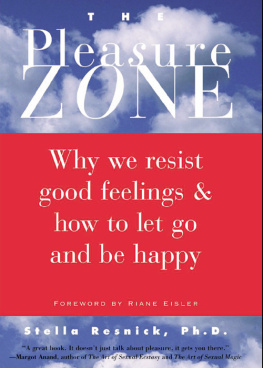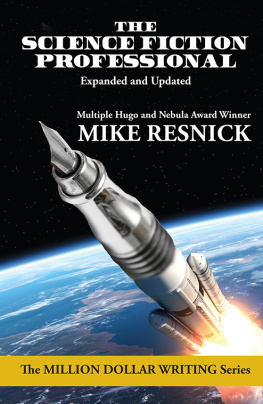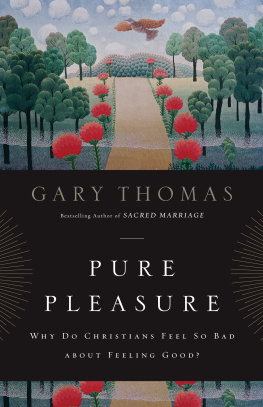
Copyright 1997 by Stella Resnick
All Rights Reserved. No part of this book may be used or reproduced in any manner whatsoever without written permission, except in the case of brief quotations in critical articles or reviews. For information, contact Conari Press, 2550 Ninth Street, Suite 101, Berkeley, CA 94710-2551.
Conari Press books are distributed by Publishers Group West
Art Direction: Ame Beanland
Cover Design: Nita Ybarra
Author Photo: Mitchell Rose
Interior Design: Jennifer Brontsema
ISBN: 1-57324-071-0
Library of Congress Cataloging-in-Publication Data
Resnick, Stella, 1939
The pleasure zone : why we resist good feelings & how to let go and be happy / Stella Resnick.
p. cm.
Includes bibliographical references.
ISBN 1-57324-071-0 (hardcover)
1. Pleasure. I. Title.
BF515.R47 1997
152.42dc21
97-15651
Printed in the United States of America on recycled paper.
10 9 8 7 6 5 4 3 2 1
For Alan,
the great love of my life
For Dad,
a constant caring presence
In Memory of
Holly Harp
Janet Lederman
Foreword
The Pleasure Zone is a remarkable book, a wise and practical book written by a wise and practical woman. It takes us to where we all liveour bodiesand offers simple, sensible tools to help us move toward what we all want: healthy and fulfilling lives.
For me, The Pleasure Zone is a particularly exciting book. I have spent the last two decades probing this question of pleasure. Why, when our most basic human yearning is for pleasure, has pleasure been vilified, forbidden, and often distorted into pleasure at the expense of others? Why do we carry so much negative luggage about pleasure? What can we do to accelerate what in my book Sacred Pleasure I call the pain to pleasure shift?
My own research has focused on the larger cultural and historical pictureon how we need to shift to a society that supports and rewards partnership rather than domination if we are to reclaim our birthright to pleasure. The more our society supports and rewards caring in all spheres of life, the more pleasure can be a part of our day to day lives. But personal and social change go hand in hand. The more pleasurably embodied we become, the more our day to day relationships become loving and the more sexually, spiritually, and socially healed our society becomes. The Pleasure Zone focuses on this personal healingand it does this beautifully.
Unlike so many so-called self-help books, The Pleasure Zone is really helpful. It is grounded in sound research. It distinguishes between real pleasure and the escapism that, under the guise of fun, leaves us feeling empty, disconnected, and in danger of becoming hooked on harmful, and in the long run painful, addictions.
The Pleasure Zone is also real in another way. Throughout, Stella Resnick speaks to us out of her own personal and professional experiencesand she does this with honesty, caring, and charm.
But that is not all.
The Pleasure Zone does not ignore the spiritual dimension of feeling goodwhat I have called sacred pleasure. On the contrary, there is a spiritual dimension throughout the book. But it is not the old disembodied spirituality that denigrates our bodies and the rest of nature. Rather, it is a full-bodied partnership spirituality that celebrates the wonder, and miracle, of our great capacity for love and creativity, for feeling good and helping others to do the same.
I consider The Pleasure Zone an important contribution to the reclamation of true pleasure. And I found it a pleasure to read!
Riane Eisler
Contents
1. The New Pleasure Principle,
Discovering the connection between happiness and pleasure
2. Why We Say No to Pleasure,
How we have been trained to resist pleasure
3. Keys to Reaching Your Pleasure Potential,
What pleasure actually is and how to be positively motivated
4. The Eight Core Pleasures: A Developmental History of Delight,
Recognizing the full spectrum of pleasures
5. Primal Pleasure: Sweet Surrender,
The first step in intensifying pleasure is learning to let go
6. Pain Relief: Turning Pain into Pleasure,
How to first soothe, then release, resolve, and acquire wisdom from pain
7. The Elemental Pleasures: Play, Laughter, Movement, and Sounding Out,
How to lighten up
8. Mental Pleasures: Mind Matters,
How to think good thoughts
9. Emotional Pleasures: Variations on a Theme of Love,
How to feel good feelings
10. Sensual Pleasures: Sense and Sense Ability,
Becoming more sensuous
11. Sexual Pleasures: Complete Fulfillment,
Turning up the heat
12. Spiritual Pleasures: Back to the Beginning,
The joys of a buoyant spirit
Acknowledgments
This book has been a long time in the making. I wrote my first article on pleasure deprivation for New Age magazine in 1978. Two years later, I followed it up with another on the connection between conscious breathing and the ability to enjoy both lasting love and fulfilling sex. From that time on, pleasure has been my life's workand, contrary to what might be expected from such a seemingly benign issue, it hasn't been easy. Nor has it been without controversy. I'm indebted to all the people who have supported me over the years in a variety of ways, both personal and professional. I particularly thank Peggy Taylor, then editor of New Age, for mid-wifing that very first artcle through me.
I'm especially grateful to the people who have worked with me in private therapy, groups, and workshops, and to those who have learned to use a pleasure-positive perspective to transform their lives. Witnessing their success has been tremendously gratifying to me. I owe a special thank you to all those who have been disguised in this book and whose anonymous stories have been used to provide insight into the dynamics of pleasure-resistance and how to overcome it.
I have also continued to develop my ideas and methods in professional seminars and conferences. Particularly in the early years, my warmest receptions on the topic of pleasure were always among sexologists, sex educators, and sex therapists. I specifically want to thank the Society for the Scientific Study of Sexuality, a stimulating group of thinkers and researchers which, for over fifteen years, has been an endless source of valuable professional development and collegial support. I am also grateful to the Association for Humanistic Psychology and the Somatics Community of the Association for Humanistic Psychology for many years of support and exchange of ideas.
Since I have been researching the topic of pleasure over a long period of years, I fear that I may fail to acknowledge all those whose work has influenced mine. Though it's not possible for me to list them all, still I want to extend my appreciation to any I have failed to specifically mention, who nonetheless have contributed greatly toward clarifying my ideas on the importance of pleasure in everyday life.
Committing my ideas to the page has not been an easy task for me. I'm grateful to Nancy Bacal, my friend and teacher, and all the women of the now defunct Wednesday group, who for six years cheered me on as a writer.
In the many years it has taken me to research and put together a coherent manuscript, there are two people whose specific help has been invaluable. I owe a special debt of gratitude to Diane Rapaport, author and cherished friend, who helped me separate wheat from chaff in early versions of this book. I am also indebted to Dr. Carol Cassell, another cherished friend and a colleague, for her continual encouragement, no-holds-barred feedback, and other useful input in both early and final drafts.
Next page








